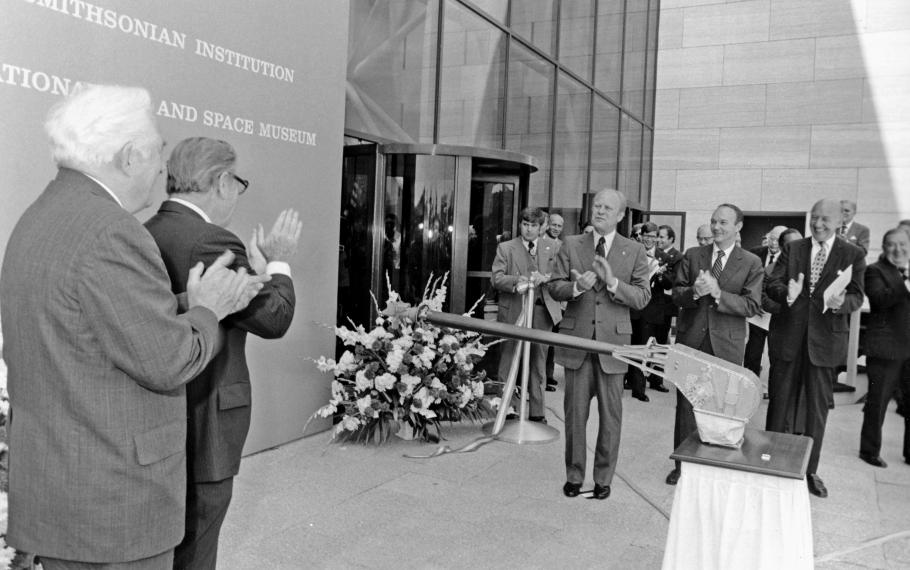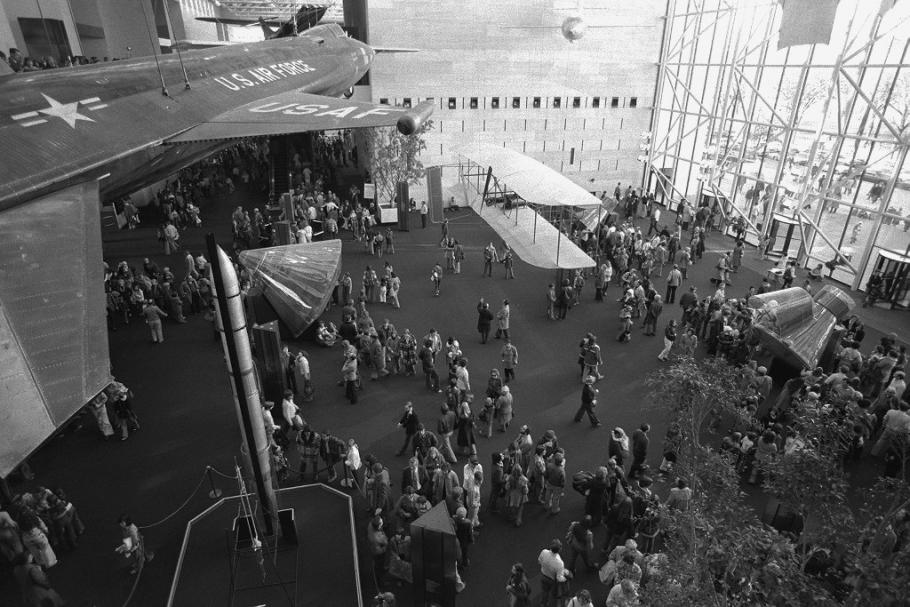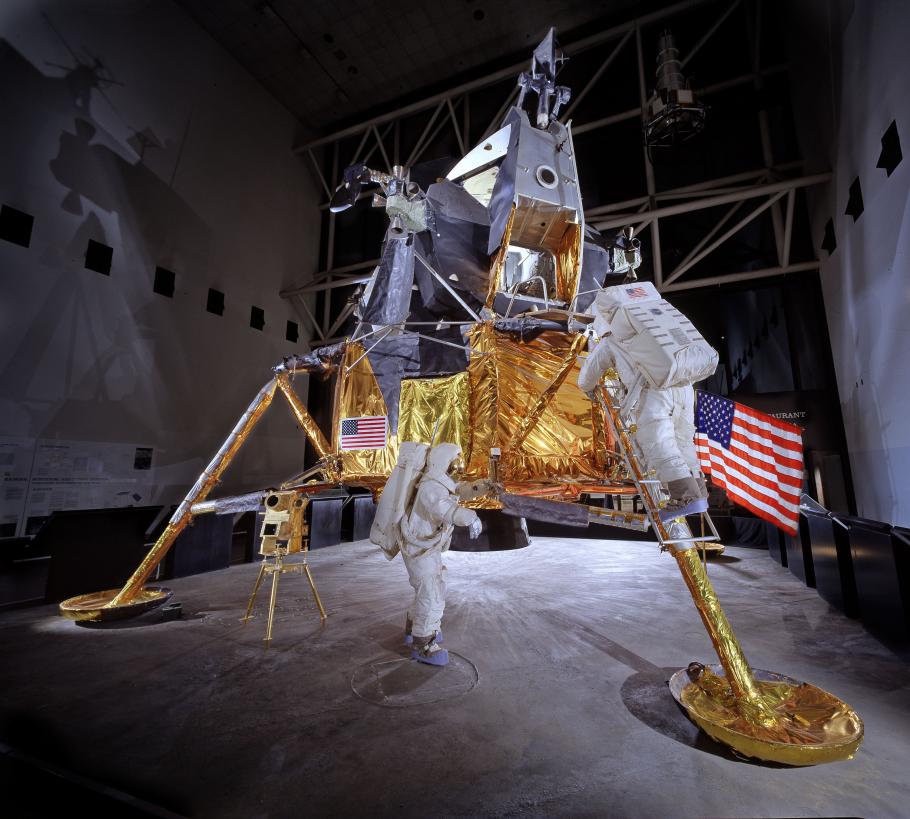On July 1, 1976, President Gerald Ford presided over the ribbon-cutting ceremony at the opening of the new National Air and Space Museum building on the National Mall. A red, white, and blue ribbon across the entrance was severed when a signal sent from the Viking 1 spacecraft orbiting Mars activated a mechanical arm identical to one on the Viking Lander on the surface of Mars. The Museum’s doors were open. More than a million people streamed through those doors in just the first month. Over a quarter billion more would follow in the nearly four decades since. The National Air and Space Museum has provided a myriad of experiences and memories for the many who have visited. But there is one experience they have all shared. Every visitor has begun their exploration of the Museum by passing through the Milestones of Flight gallery.
Planners of the new Museum in the 1970s decided that each of the 26 galleries would focus on a single subject area, and collectively they would present the overall history of aviation and spaceflight. But the central entrance space, the Milestones of Flight gallery, was also intended to greet the visitors coming through the front door with an awe-inspiring visual experience, immediately surrounding them with a number of the most significant and striking artifacts in the collection. Once inside, the original 1903 Wright Flyer, the world’s first airplane, appeared to be flying right toward you. Look up to the right and the Bell X-1, the first aircraft to break the sound barrier, was on view. Moving further into the gallery you encountered John Glenn’s Mercury capsule, Friendship 7. And the across the gallery was the Apollo 11 Command Module, Columbia, that carried humans back to Earth from our first journey to the Moon. Looking up from there was Charles Lindbergh’s Spirit of St. Louis, and the exotic X-15, still the highest flying, fastest flying airplane in history. And if that weren’t enough to whet your appetite for what this stunning museum had to offer, you could touch a Moon rock brought back by the Apollo 17 astronauts, literally making your visit out of this world. For nearly 40 years, Milestones of Flight has done just what the planners had intended. It signaled to every visitor who walked through front door: you are about to have one of the most exciting museum experiences of your life. Just a few minutes after arrival, visitors were assured they were in a place like none other.
Since the Museum opened, one by one, new galleries replaced the original 1976 offering with exhibitions featuring new acquisitions, enriched learning experiences based on fresh historical scholarship and scientific discoveries, new educational approaches, digital and interactive experiences, and ever-evolving exhibit technology. The Museum has continually renewed itself over the decades, providing our many repeat visitors with fresh experiences and new things to learn, and always ensuring first-time, or one-time, visitors an unforgettable encounter with one of the most compelling stories of human achievement. A consistent thread through it all has been the Milestones of Flight gallery. The eye-opening, jaw-dropping first look at one the world’s great museums for new visitors, and the space for returning visitors to see familiar treasures that never lose their power to captivate even those who know the inspiring stories they represent. In the planning now, and opening to the public in 2016, Milestones of Flight will have its first major update since that first million visitors passed through the gallery in July 1976. Over the years there have been some changes in Milestones. To mark the 1988 INF nuclear disarmament agreement, Pershing II and SS-20 missiles were added to the gallery in an exhibit called Trust but Verify. In 1999, the Breitling Orbiter 3 gondola was included after it made the first circumnavigation of the globe by balloon. In 2005, SpaceShipOne, winner of the Ansari X Prize for the first privately developed reusable human spacecraft, was suspended alongside the Spirit of St. Louis and the Bell X-1. In 2008, Stardust, the first spacecraft to return to Earth with material from a comet, took its place on the floor of Milestones. In 2003, the Wright Flyer was removed from Milestones and placed in its own gallery with a special exhibition for the centennial of the Wright brothers first flights, where it remains today. And, of course, after the September 11, 2001, attacks, magnetometers had to be installed for the protection of our many visitors and the collection, intruding noticeably into the exhibition space. These were all significant changes, but notable upgrades of the exhibit content and interpretive elements haven’t occurred, and important improvements to visitor services needs have been piecemeal in their appearance. Boeing has now partnered with the National Air and Space Museum to enable the Museum to revitalize its powerful central entrance exhibition space. The new Boeing Milestones of Flight Hall will maintain the visually stunning, awe-inspiring first impression of the Museum that the Milestones of Flight gallery has always provided. But the new Milestones will deepen the experience with richer description and interpretation of the iconic artifacts on display (including some relocated ones like the Lunar Module LM-2), versatile digital and mobile opportunities to interact with and share content, and a more visitor-friendly design of the space to better showcase the artifacts and make visitor services and information more accessible. Also, connections will be made between the content in the Museum in Washington, DC and the Steven F. Udvar-Hazy Center in Chantilly, Virginia to reinforce the relationships between the artifacts in the two Museum sites, and to make people aware that their visit is incomplete without a trip to the Udvar-Hazy Center.
To create the new Boeing Milestones of Flight Hall, the Museum has marshaled a large team of its talented and experienced staff. One-of-a-kind milestone artifacts, leading scholarship, innovative design concepts, multifaceted cutting-edge educational techniques, the latest digital and mobile experiences, all backed up by front-end visitor evaluation to ensure we are meeting the needs of all our audiences, will combine to make the Boeing Milestones of Flight Hall among the most striking and powerful exhibitions in the entire Smithsonian. The new gallery will be completed in July 2016, the 40th anniversary of the opening of the National Air and Space Museum, and the centennial of Boeing. Make your plans now to visit the exciting new introduction to the most spectacular museum in the world.



